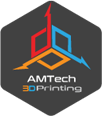
Additive Manufacturing …
The 4th Industrial Revolution
What Is Additive Manufacturing (3D Printing)?
Additive Manufacturing is the process of joining materials to make 3D objects from model design data.
The objects are built layer by layer, as opposed to traditional subtractive manufacturing methodologies.
Three dimensional printing, or additive manufacturing, goes beyond the capability of printing in the traditional sense of ink on paper, allowing for 3D objects to be physically printed before your very eyes.
3D printers allow you to create prototypes, models and products out of materials such as plastics, paper and metals.
The printers do this by creating layer upon layer of your design in your chosen material until the final product is formed.
3D printing allows companies and individuals to rapidly prototype ideas for new parts or products and also promises to cut down costs on the creation of products through savings in supply-chains, product waste and storage.

